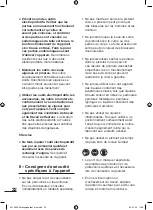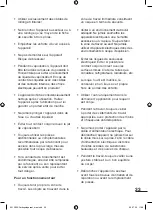
46
housing. Check the atomiser valves
and the secure fitting of the discharge
nozzle.
2. The pressure of the liquid output can be
checked using the control knob (2).
Turn the knob clockwise to increase
the pressure. Turn the knob counter
clockwise to reduce the pressure. Select
a central setting and find the appropriate
pressure while test spraying.
With water discharge
• Paints on a water basis: Add thinner
or mix with another low-viscous paint.
• Oil paints: Thin paints.
General spraying tips
1. The 0.5 mm discharge nozzle that
is preinstalled at the factory is
completely adequate for most paint
applications in and outdoors.
2. Use the 0.8 mm discharge nozzle for
more viscous and thick latex paints.
3. Should the mist discharged seem
very slight and unbalanced as far as
volume goes, the paint is too thick
or too viscous. To get a better result,
first of all try to change the pressure
by adjusting the control knob. If
this is not possible, thin the paint
accordingly.
4. Should the mist discharged appear too
heavy with weak concentration, raise
the pressure by turning the control
knob clockwise or use a discharge
nozzle with a smaller diameter.
Thinning (Fig. 2)
ATTENTION! Pull the mains plug,
before filling the tank with paint.
Most paints are delivered ready-mixed
and must be thinned before they can be
sprayed. The manufacturer’s instructions
must be observed with regard to paint
thinning for the spraying operation. The
viscosity beaker will help to determine
the correct viscosity for the paint used.
To this end, fill the beaker with paint up
to the brim. Time how long it takes for
the beaker to be emptied into the paint
tin. The table below shows the times
recommended for various materials:
Artificial resin and latex
paints
24–28 seconds
Paints on a water basis 20–25 seconds
Priming paints
24–28 seconds
Clear varnishes
20–25 seconds
Oil paints
18–22 seconds
Enamel paints
18–22 seconds
Aluminium paints
22–25 seconds
Vehicle undersealing
25–35 seconds
Wood primers
28–35 seconds
Wood preservatives
No thinning
required
Wood varnishes
No thinning
required
Should emptying the paint take longer
than the time recommended, then further
thinning will be necessary. To this end,
add a small quantity of the suitable thinner
and test its viscosity until the right one is
reached. Some paints meant for spraying
contain particles or lumps and should be
sieved before the paint tank is filled.
8 – Mode of operation
The surfaces to be worked must be free
of dust, dirt and grease. Surfaces that
are not to be sprayed must be covered
with good-quality adhesive tape. The paint
or liquid to be sprayed must be mixed
thoroughly and be free of any lumps or
other particles. Numerous substances
can be sprayed with this spray gun.
5412950-Farbspritzgeraet_man.indd 46
5412950-Farbspritzgeraet_man.indd 46
09.07.20 11:38
09.07.20 11:38
















































